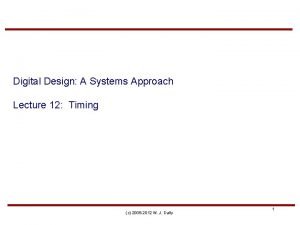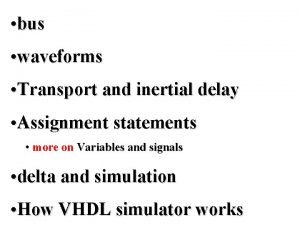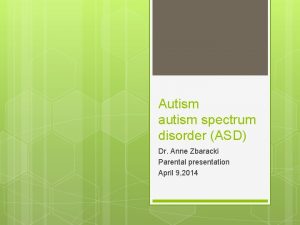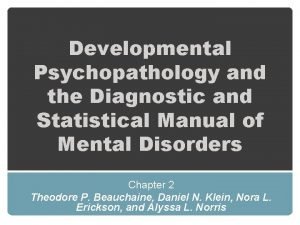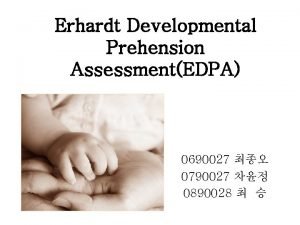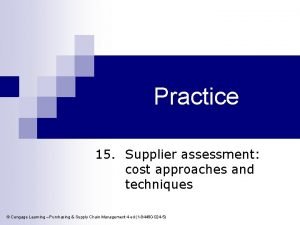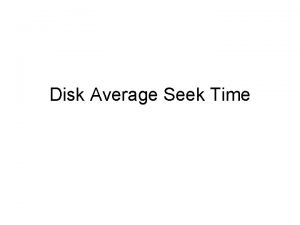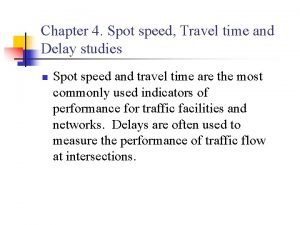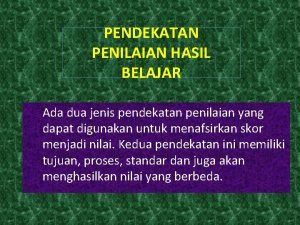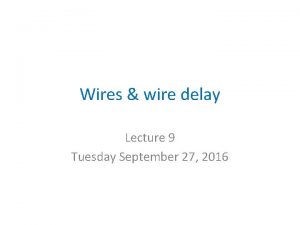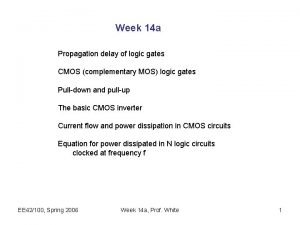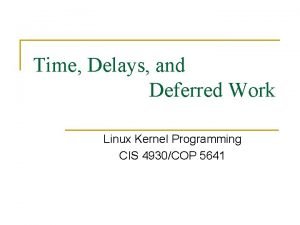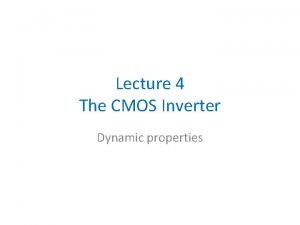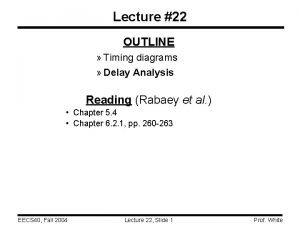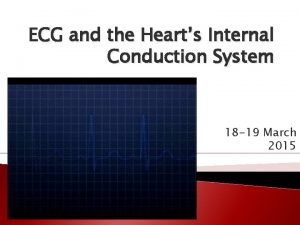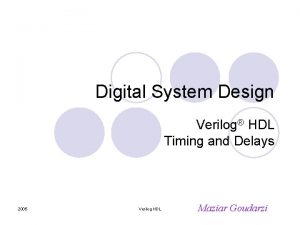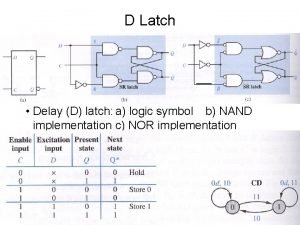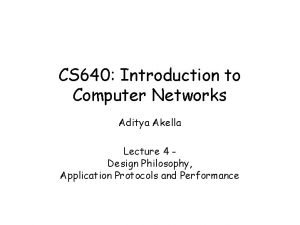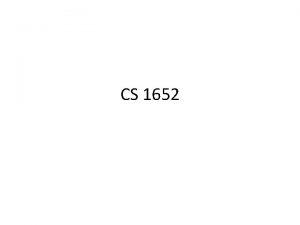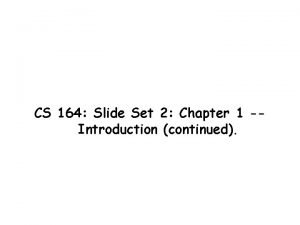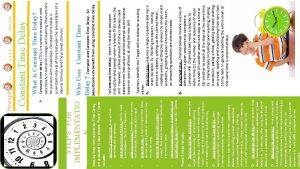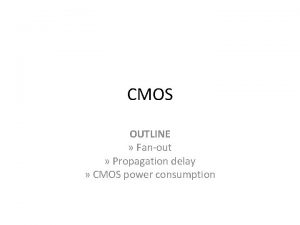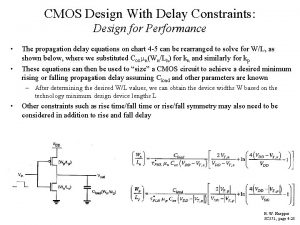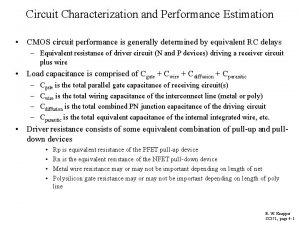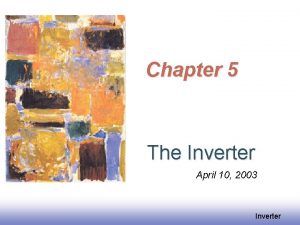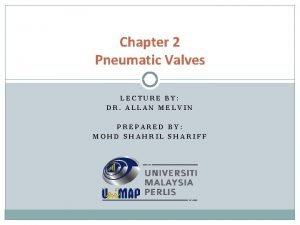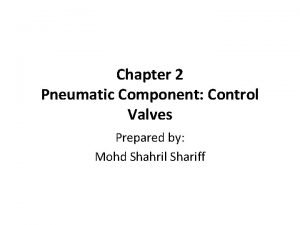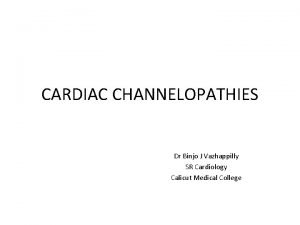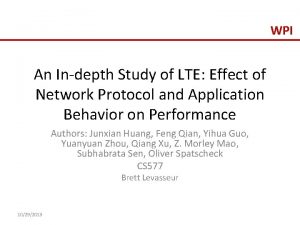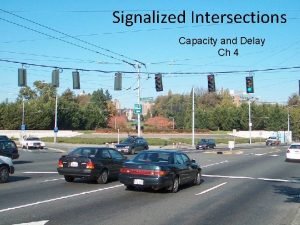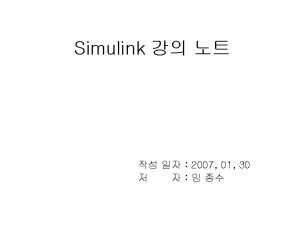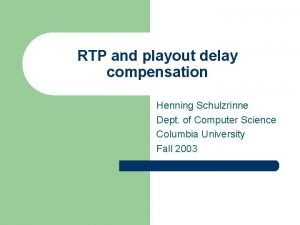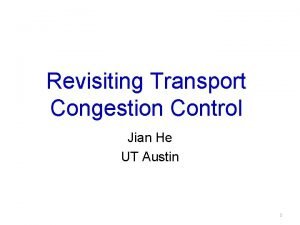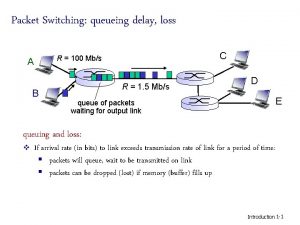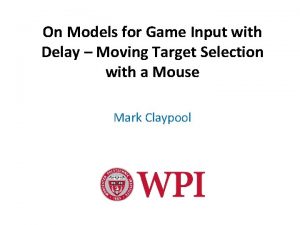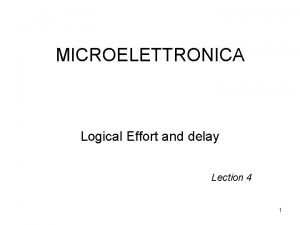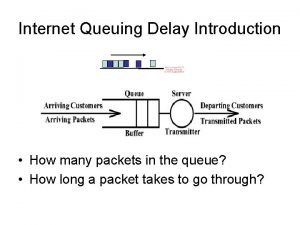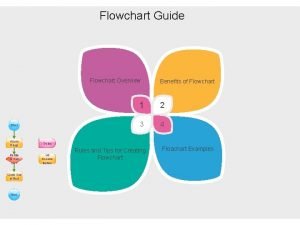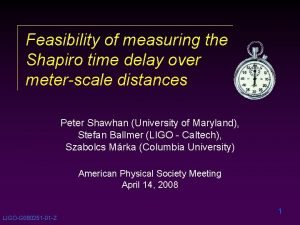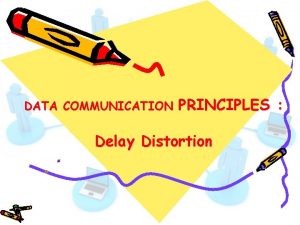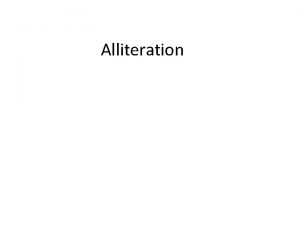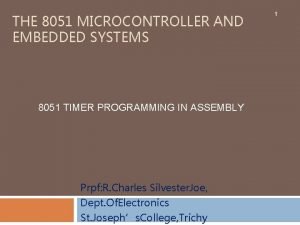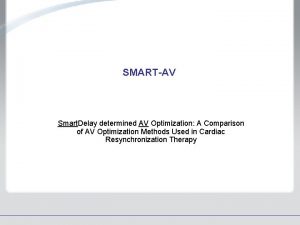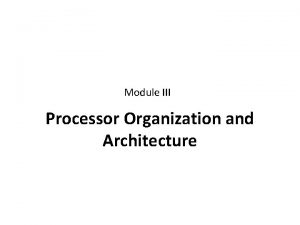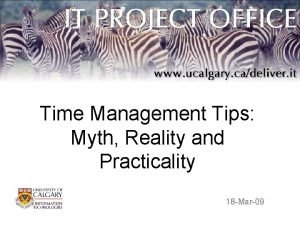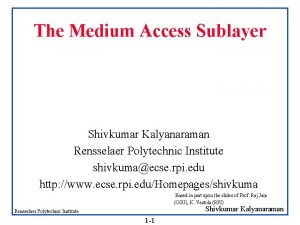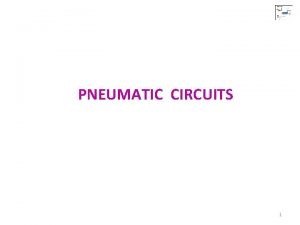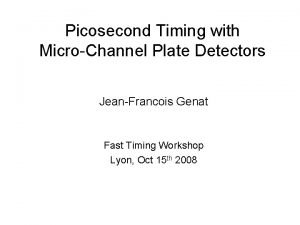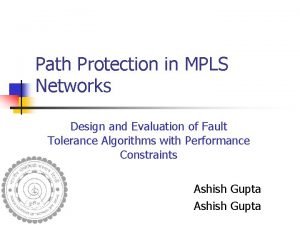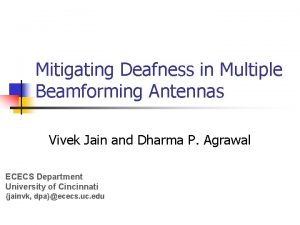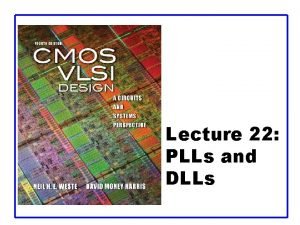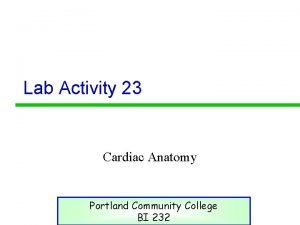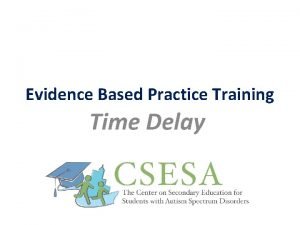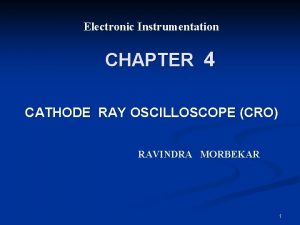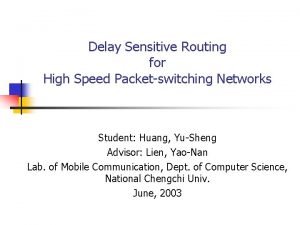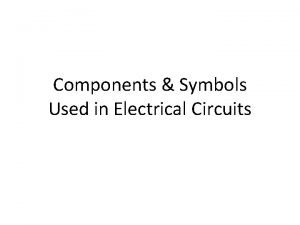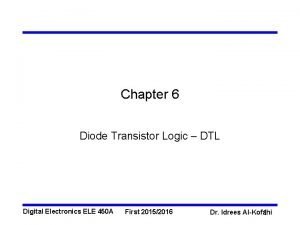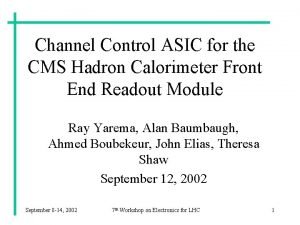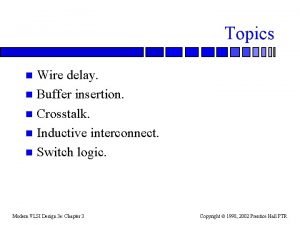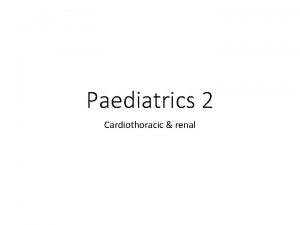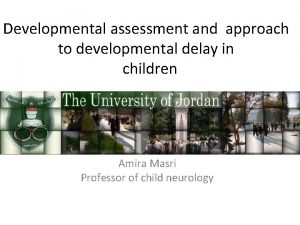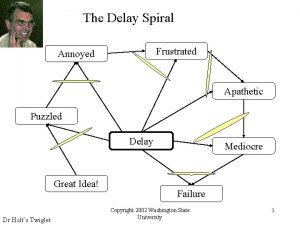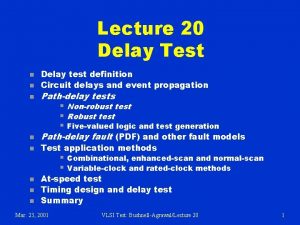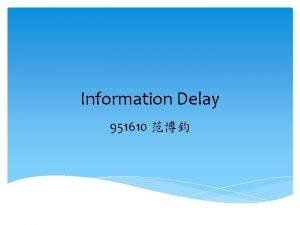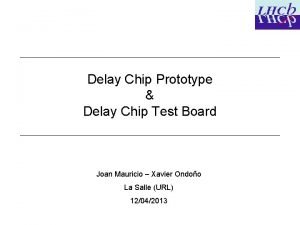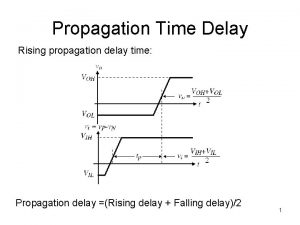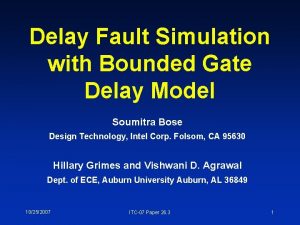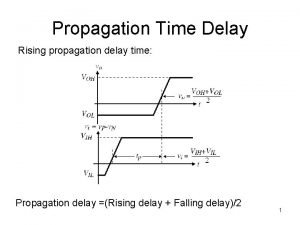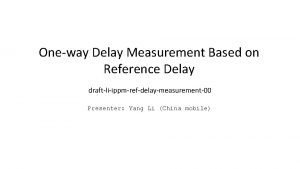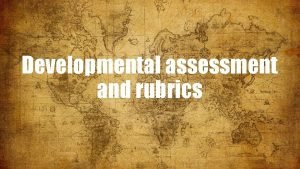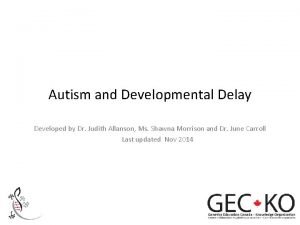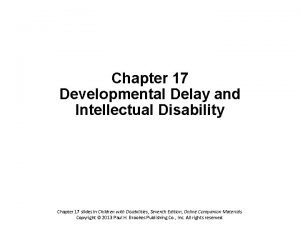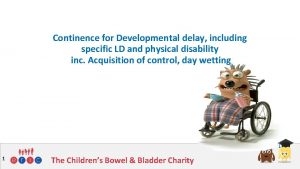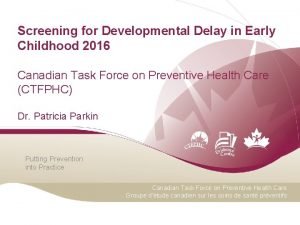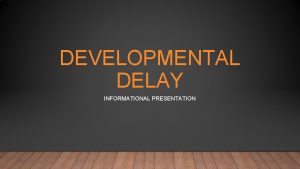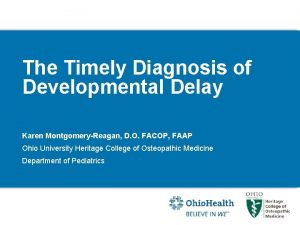Developmental assessment and approach to developmental delay in





































































































- Slides: 101

Developmental assessment and approach to developmental delay in children Amira Masri Professor of child neurology

What is normal development • humans develop through a dynamique sequential process since the early days of life as embryo and the process continues after birth

Development Child's development is a dynamic process

What are the developmental milestones • • • gross motor fine motor/adaptive Language Social Vision + hearing should be assessed

vision • Visual fixation : by 35 weeks of gestation fixation is present • 2 months : follows objects to 180 degree • Preference to human faces • Visual acuity : very low , reaches approximate adult levels by 1 year of age • Accommodation + convergence : 2 -3 months

Vision –cont. • • • Visual field : approximate adult level by 1 year of age saccade : since birth , but slower than in adults Categorization of colors : since birth Categorization of orientation : since birth The visual system reaches its full maturity at the age of 10 -11 years

Hearing • Development of hearing : excellent since birth (since 5 th month of fetal life ) • In the first 10 months of life : hearing is the dominant sense , after this period visual sense predominates

Hearing –cont. • Hearing assessment : difficult in infants • The examiner must be behind the infant • The infant turns to the source of noise by the age of 3 months but this test is neither accurate nor constant : ie if the infant doesn’t turn to the voice it is not necessarily that he doesn’t hear. The test is variable from one moment to another

Gross motor function –first year of life • Neonate : moves head from side to side • 1 m: raises head momentarily when prone • 2 m: raises head (sustained ) when prone • 3 m: raises head above plane of body

Gross motor cont. • 4 m: supports weight , full head control, sits with full truncal support

Gross motor • 7 m: sits with pelvic support, rolls over • 10 m : sits alone, crawl , pulls to standing position , walks holding in furniture • 12 m: walks with hand held • 15 m : walks alone, crawls upstairs • 18 m : runs stiffly , walks upstairs one hand held • 24 m=2 years : runs well , up+ downstairs one step at a time

Gross motor • 2. 5 years : upstairs alternating feet • 3 years : rides tricycle , stands momentarily on 1 foot • 4 years : hops on 1 foot , throws ball • 5 years : skips

Fine motor

Fine motor/ adaptive 3 m : opens hand spontaneously , reach objects 4 m : reaches towards objects+ put in mouth 6 m-7 : transfer from hand to hand 10 m : thumb index grasp, releases objects grasped by others • 12 m : releases object on demand • •

Fine motor /adaptive -cont. • 15 m : 3 cubes • 1. 5 years : 4 cubes , imitates vertical stroke • 2 years 7 cubes , imitates horizontal stroke • 2. 5 years : 9 cubes , makes vertical + horizontal stroke • 3 years : circle • 4 years : cross , square , draw a man test

Language 3 m : aah , ngah 7 m : pollysylabisc vowels 10 m : few words besides mama , dada 15 m: follows simple commands , may name a familiar object • 18 m: 10 words , names pictures , identifies parts of body • •

• 2 years : put 3 words together • 4 years : tells a story , count 4 pennies correctly • 5 years : counts 10 pennies correctly

Social • Neonate : visual preference to human face • 1 m : beginning to smile • 2 m : social smile , listen to voice + coos • • • 3 m : sustained social contact • 7 m : enjoys mirror , prefers mother • 10 m : waves bye , plays peek a boo , responds to sound of name 4 m : laughs loudly, excited at sight of food

Social • 1 year : plays simple boy game , postural adjustment to dressing • 15 m : hugs parents , indicates desires by pointing • 1. 5 year : feeds self , kisses parents with pucker • 2 years : listen to stories with pictures • 2. 5 years : pretend in play

Social –cont. • 3 years : plays simple games with children , washes hands unbutton clothing , put on shoes • 4 years : goes to toilet alone , plays with several children ( role playing ) • 5 years : dresses + undresses , asks questions about meaning of words

Red flags worrisome if still not reached o babbling by 12 months o gesturing (e. g. , pointing, waving byebye) by 12 months o single words by 16 months o two-word spontaneous (not just echolalic) phrases by 24 months o loss of any language or social skills at any age.

Developmental delay • Child not reaching developmental milestones at the expected age , even after allowing the broad variation of normality • Global developmental delay : when >2 domains in development are delayed

• The earlier the identification of these children the better outcome( birth -2 years ) • Favorable environment: enhances + optimize brain development

Consequences of Early Childhood Developmental Problems • Low self-esteem • Poor relationship formation • Poor academic success • Conduct problems • Truancy and school drop -out • Unemployment • Poor quality parenting skills

American Academy of Pediatrics Policy on Developmental Screening • All infants and young children should be screened for developmental delays • Screening should be incorporated into the ongoing health care of the child • Screening needs to be periodic • Systematically eliciting parental concerns about development is an important new method • Pediatricians should consider using standardized screening tools Pediatrics 2001; 108(1): 192 -196

Developmental surveillance • 5 -10% of pediatric population have developmental disabilities • To identify these children : developmental surveillance: 1 -observe infant 2 -take developmental history 3 -ellicit parental concerns • Developmental screen : necessary adjunct

Surveillance + screening Developmental surveillance should be performed at all well-child visits from infancy through school-age, and at any age thereafter if concerns are raised about social acceptance, learning, or behavior

Detection Rates Better With Screening Tests • 70% of children with developmental disabilities not identified without screening tests (Palfrey et al. J PEDS. 1994; 111: 651 -655) • 70%-80% of children with developmental disabilities correctly identified with screening tests (Squires et al, 1996, JDBP, 17: 420 – 427

Types of Screening Tools • Two major categories – Developmental – Behavioral • Two mechanisms of administration – Parental – Provider

Developmental screening tools • Provider – Denver – CAT/CLAMS – Bayley – Brigance – DIAL-R • Parent – Ages and Stages Questionnaire – Parent’s Evaluations of Developmental Status

Developmental screening tools • Provider – Denver – CAT/CLAMS – Bayley – Brigance – DIAL-R • Parent – Ages and Stages Questionnaire – Parent’s Evaluations of Developmental Status Review-Pediatrics Feb 2012

Denver Developmental Screening Test - 2 • • Very commonly used screening tool Birth to 6 years old Poor sensitivity and specificity (40 -60%) 10 -20 minutes to administer Normed on diverse population sample Multiple languages Domains: fine and gross motor, language, and social skills

CAT/CLAMS Clinical Adaptive Test/ Clinical Linguistic and Auditory Milestone Scale • Similar to Denver but more focused on screening language and better at catching MR • Some parental report, some direct observation by provider • Very high specificity and sensitivity (>90%) • Quick to administer due to age categories

Developmental delay • Developmental delay : Slow progress in the attainment of developmental milestones • Psychomotor regression: loss of developmental milestones previously attained.

Two important questions to answer • Is developmental • Is development delay restricted to delayed or specific areas or is regressing it global ( 2 or more )? Determine is the delay static or progressive

Predominant speech delay v. Hearing impairment v. Autism v. Bilateral hippocampal sclerosis v. Congenital bilateral perisylvian syndrome

Predominant motor delay • • • Ataxia Hemiplegia paraplegia Hypotonia Neuromuscular disorders • Determine if the motor delay is due to central ( upper motor neurone disorder ) or peripheral ( lower motor neurone disorder • Or combined : example Duchenne muscle dystrophy Cong muscle dystrophies Metachroamtic leukodystrophy

Central Peripheral

Differentiating central from peripheral causes: hx and ex Central Ø Normal or Brisk reflexes Ø Other abnormal brain functions: delay, seizures Ø Fisting Ø Scissoring on vertical suspension Ø Dysmorphic features Ø Extra-cranial organ malformations Ø Ø Ø Peripheral Absent or Depressed reflexes Intact brain function Awake and alert Muscle atrophy Profound weakness Fasciculations Ø No extra-cranial organ malformations

Global developmental delay ( 2 or more) : examples • Perinatal insult : asphyxia , congenital infections, bilirubin toxicity • Chromosomal /genetic • Metabolic : hypothyroidism , neurometabolic disorders • Cerebral malformations • Progressive neurodegenerative disorders • Determine is it static or progressive • Age of onset of symptoms • Clues in history and examination

Evaluation of the child with global developmental delay

• A child in your clinic you diagnosed him to have global delay What is the etiology for his delay? What to do next ?

• What is the etiology for this delay • developmental delay ? ? ?

Look for the hints • History : antenatal, birth history , past history • Age of Onset of symptoms : static or progressive • Family history ( very detailed ): consanguinity, similar cases , deaths in early infancy • Examination : dysmorphysm systems involvement Results of investigations

Clues in the history • Antenatal history : trauma , infection, death of a twin , hypertension , diabetes … • Birth history : weight , gestational age hyperbilirubinemia. . • Past : meningitis , encephalitis , epilepsy trauma …

What is your most likely dx based on the clues • 20 months old boy presented with history of delayed walking , he also has weakness of the right side of body • Antenatal history revealed decreased fetal movement , he was born prematurely at 28 weeks of gestation

Cerebral palsy

Cerebral palsy • Definition is a non progressive (static) disorder of motor function and movement that usually manifests early in life as a result of central nervous system damage to the developing brain

Epidemiology Incidence : 1. 5 to 2. 5 per 1, 000 live births • Most patients are identified by 2 years of age due to delayed motor milestones

Epidemiology • More common in children who are born very prematurely or at term • Slightly higher prevalence in males M: F= 1. 5: 1 • Poor prenatal care may increase the incidence of cerebral palsy

Causes and risk factors onset prenatal § perinatal § postnatal §

In most cases, the exact cause is unknown but is most likely multifactorial Majority of cases : not caused by hypoxic ischemic incidents occurring perinatally (as it was believed until recently. ) 70 -80% cases are prenatal in origin Although prematurity is the most common known antecedent of CP, the majority of children who develop CP are born at term.

• 70% - 80% of cases of CP are due to antenatal factors • 10% - 28% of cases are due to birth asphyxia in term and near-term infants • More than 1 etiologic factor is often identified.

Classification • The term CP is descriptive : different etiologies and clinical presentations 1 - According to the extremities involved 2 -According to the characteristics of neurologic dysfunction. 3 - Functional classification

According to the extremities involved - Monoplegic Hemiplegic Diplegic Quadriplegic Qudriplegic 6% § Hemiplegic 33% § Diplegic 44% § .

Hemiplegic CP • Arm > leg • walks : tip toes , swing the affected leg ( semicircular arc ) • Corticosensory impairment: common • Mental retard. : 1/3 • Seizures : 1/3 • vision

Spastic quadreplegic CP Generalized increase in muscle tone Legs > arms Opisthotonic posture ( first year of life ) Difficulties in swallowing and articulation Incoordination of oropharyngal m : recurrent pneumonia • Seizures : 50% • Mental retardation : majority • Auditory , visual abn : common • • •

Spastic diplegic CP • Bilateral leg involvement • Commonly some degree of UL involvement • Infant : scissoring , older child : tip toewalk • Seizures , MR , visual abn

: According to neurological dysfunction – Spastic: most common type ( 70%-80%) – Ataxic: with cerebellar involvement – Dyskinetic (extrapyramidal, choreoathetoid): due to predominant basal ganglia involvement in patients with acute severe hypoxia and kernicterus. Symptoms consistent with a movement disorder may appear later in life – Mixed

Diagnosis : HX + EX • Diagnosis : always a motor deficit • usual presentation : delayed motor milestones • hand preference < 3 years: relative weakness of 1 side. • History: the child is not losing function= the patient does not have a progressive disease. • Examination : hypotonia , spasticity, persistent primitive reflexes , underdevelopment of parachute reflex

Cont. DX • History+ neurologic examination = patient’s motor deficit is due to a cerebral abnormality: lead to DX of CP( no dx lab test) • Serial examinations may be necessary to assure the diagnosis of CP, especially when the history is not reliable.

Associated conditions • Mental retardation : 30 - 50% • Ophthalmologic defects : 30% • Hearing impairment : 10% • Speech and language disorders : 40% • Epilepsy : 30 - 40 %

Mangement and ttt • Multidisciplinary team • goal for the treatment program : maximize function + optimize development = help them participate in as many activities as possible in multiple social settings

Types of interventions • Physical therapy • Orthopedic surgery (later) • Muscle tone management • orthosis

What is your diagnosis ? Clues in the family history • A 4 year old boy presented with history of global developmental delay , epilepsy and microcephaly • Parents are cousins , he has one cousin who was diagnosed to have phenylketonuria by neonatal screening

phenylketonuria Error of amino acids metabolism Autosomal recessive No acute clinical symptoms Untreated leads to mental retardation Associated complications: behavior disorders, cataracts, skin disorders, and movement disorders • First newborn screening test was developed in 1959 • Treatment: phenylalaine restricted diet (specialized formulas available) • • •

Phenylketonurea : fair complexion

Clues in the examination • Dysmorphic features : suggestive of a specific syndrome • Other organs involved

What is your diagnosis : clues in the face ?

Clues : skin • Neurocutaneous disorders : examples v. Neurofibromatosis type 1 v. Sturge weber syndrome v. Tuberous scleoris

Clues in skin ? ?

Neurofibromatosis type 1 • • Autosomal dominant with variable expression Most common neurocutaneous syndrome Diagnosis: dx criteria Macrocepahly is common Learning disability Risk of neoplastic disorders Seziures Treatment : supportive

Diagnostic criteria for NF 1 > 2 of the following • 6 café au lait spots (>5 mm in prepubertal or >15 mm in postpubertal individuals • >2 neurofibromas or one plexiform neurofibroma • freckling in axillary or inguinal region • optic glioma • >2 iris hamartomas (Lisch nodules • distinctive osseous lesion such as sphenoid dysplasia or thinning of long bones • first-degree relative with NF 1.

Clues in the skin

Tuberous sclerosis • Autosomal dominant • 2 genes ( TSC 1 and TSC 2 ) • Characteristic skin lesions ( ash leaf , shagreen patches , achromic spots , sebaceous adenoma …. ) • Epilepsy , developmental delay • Subependymal hamartomas • Dx : dx criteria



clues in skin : rash, dermatitis Biotinidase deficiency • • Propionic acidemia(orgnic acidemia) • Refsum disease(peroxysomal disorder)

Clues in hair : Abnormal hair Eg: Menkes disease • global delay + hair coloreless , friable, kinky Low cupper + cerulolasmin

Clues in hair : abn color • Autosomal recessive • Silvery hair • Hemophagocytic disorder • Griscelli syndrome

Clues in the eyes • Cataracts : -Galactosemia -Zellweger syndrome - Lowe syndrome -Other conditions • Dislocated lenses: -Homocystinuria, - Molybdenum co-factor deficiency -Sulfite oxidase deficiency •

• Retinal degenerative changes -peroxisomal disorders -others Cherry red spot : (mainly lipid storage disease ) -Neimann pick -Tay sack -GM 1 gangliosidosis -Sandhoff disease -Metachromatic leukodystrophy -mucolipidosis

Then to summerize • History and examination : very important guides towards investigations and diagnosis • If there is no clinical features to suggest a specific diagnosis less likely to find a diagnosis • Lab investigations : necessary to reach for a final diagnosis

What lab investigations ? • If family history of specific disorder – screen for that disorder

Clues in examination • If there is a hint : investigate accordingly : examples Cpk , gene for duchenne Karyotype

If no hint , what to do ?

Hearing+ vision assessment • Should be done for all developmentally delayed children

Metabolic screen • Should be performed if not done in the neonatal period • Amino acids , organic acids , lactate , ammonia

Cytogenetic studies • Routine screen ( yield is 3. 7% ): it is indicated in the evaluation even in the absence of dysmorphic features • Testing for fragile X ( yield 2. 6% ): particularly if positive family history of developmental delay • Females : frequently affected , may also be considered for testing

Cytogenetics –continue • Dx for Rett syndrome ( second most common cause of severe mental retardation after Down’s syndrome in females ) • Considered in females with unexplained moderate to severe mental retardation • Test for MECP 2 gene deletion

Cytogenetics –continue • In children with unexplained moderate to severe delay : FISH , micosatellite markers to assess for subtelomeric rearrangements (yield 6. 6% )

Thyroid function test • If not done in neonatal period should be done

Lead levels • Targeted screening ( risk factors for excessive environmental lead exposure)

EEG • Not recommended in the routine evaluation if child does not seize

neuroimaging • MRI brain : abn detected in 48 -65% of cases

• MRI brain : abnormality detected in 48 -65% of cases Clue Diagnostic Review-Pediatrics Feb 2012

After all Investigations History examination In how many patients you can reach towards a final diagnosis ? ? ? ? Review-Pediatrics Feb 2012

• Reports from previous studies on the etiology of GDD are variable and range from 40% - 60% • Variability in the proportion of determined etiologies differences in technological capabilities thoroughness of evaluation characteristics of the original sample

Diagnostic rate 44. 5%

Whole exome sequencing (WES) • Powerful tool for etiological discovery in neurodevelopmental disorders A high-throughput genetic sequencing method that focuses on the protein-coding regions of the genome While protein-coding genes constitute only 1% of the human genome, they are home to 85 % of mutations underlying monogenic disorders Diagnostic rate : 40 -60% Available as diagnostic test costs around 1000 JD Should be done if all of the previous investigations did no t reveal any cause

Conclusion • Developmental assessment is very crucial • History and examination are very helpful • Tremendous improvement in genetic progress gives hope to many families
 Propagation delay
Propagation delay Difference between signal and variable in vhdl
Difference between signal and variable in vhdl Timers in plc
Timers in plc Autism prognosis
Autism prognosis Developmental psychopathology approach
Developmental psychopathology approach Erhardt developmental prehension assessment
Erhardt developmental prehension assessment Difference between datagram and virtual circuit approach
Difference between datagram and virtual circuit approach Deep learning approach and surface learning approach
Deep learning approach and surface learning approach Cost approach and techniques in supplier assessment
Cost approach and techniques in supplier assessment What is a disk seek
What is a disk seek Travel time and delay studies
Travel time and delay studies Delay and dispute mitigation
Delay and dispute mitigation Delay and sum beamforming
Delay and sum beamforming Cognitive approach vs behavioral approach
Cognitive approach vs behavioral approach Fine grained screening
Fine grained screening Approach approach conflict
Approach approach conflict Bandura's reciprocal determinism
Bandura's reciprocal determinism Research approaches definition
Research approaches definition Traditional approach to systems implementation
Traditional approach to systems implementation Pendekatan penilaian pembelajaran
Pendekatan penilaian pembelajaran Holistic approach
Holistic approach Wire delay
Wire delay Propagation delay formula
Propagation delay formula Tasklet_hi_schedule
Tasklet_hi_schedule Delay models in data networks
Delay models in data networks Ideal inverter
Ideal inverter Propagation delay timing diagram
Propagation delay timing diagram Distributed rc delay model
Distributed rc delay model Decfsz
Decfsz The boy shouted, “madam, i’m adam!”
The boy shouted, “madam, i’m adam!” Av node delay
Av node delay Verilog
Verilog D latch
D latch Bandwidth-delay product
Bandwidth-delay product Bandwidth delay product example
Bandwidth delay product example Bandwidth-delay product
Bandwidth-delay product Constant time delay
Constant time delay What is fanout in vlsi
What is fanout in vlsi Propagation delay formula
Propagation delay formula Circuit characterization
Circuit characterization Propagation delay formula
Propagation delay formula Average delay in traffic engineering
Average delay in traffic engineering Elmore
Elmore Supply air throttling
Supply air throttling Supply air throttling and exhaust air throttling
Supply air throttling and exhaust air throttling Delay after depolarization
Delay after depolarization 아레나 시뮬레이션 예제
아레나 시뮬레이션 예제 Arduino interrupt örnek
Arduino interrupt örnek Adaptations without delay
Adaptations without delay Queuing delay
Queuing delay Saturation flow rate
Saturation flow rate Simulink
Simulink Playout delay
Playout delay Rtt
Rtt Dnodal
Dnodal Game maker delay
Game maker delay Best stage effort
Best stage effort Time slice windows analysis
Time slice windows analysis Queuing delay
Queuing delay Queuing delay
Queuing delay Powerpoint animation delay more than 60 seconds
Powerpoint animation delay more than 60 seconds Alarm flowchart
Alarm flowchart Shapiro time delay
Shapiro time delay Delay distortion in data communication
Delay distortion in data communication Sniffing
Sniffing Alliteration ad
Alliteration ad You may delay, but time will not explain
You may delay, but time will not explain Tmod register
Tmod register Smart delay
Smart delay Pulse doppler radar vs mti
Pulse doppler radar vs mti Mti vs pulse doppler radar
Mti vs pulse doppler radar Decision box in flowchart
Decision box in flowchart The weather was terrible. ___ we decided to delay our trip
The weather was terrible. ___ we decided to delay our trip Ethertype 88b5
Ethertype 88b5 Time management is a myth
Time management is a myth One way propagation delay
One way propagation delay Summing junction flowchart
Summing junction flowchart Single acting cylinder valve
Single acting cylinder valve Delay lock loop
Delay lock loop Protect
Protect Opencore takeoff delay
Opencore takeoff delay End to end delay
End to end delay Delay lock loop
Delay lock loop Right pulmonary artery
Right pulmonary artery Void run
Void run Transmission delay
Transmission delay Delay lock loop
Delay lock loop Volleyball ref stand
Volleyball ref stand Delay lock loop
Delay lock loop Progressive time delay
Progressive time delay Cathode ray oscilloscope block diagram
Cathode ray oscilloscope block diagram Delay
Delay Overload contact symbol
Overload contact symbol No boyfriend no problem pmv
No boyfriend no problem pmv Modified dtl
Modified dtl Delay lock loop
Delay lock loop Strips of tinfoil winking like people
Strips of tinfoil winking like people Roundtrip delay
Roundtrip delay Fee concession application
Fee concession application Wire delay
Wire delay Branch delay slot
Branch delay slot Radiofemoral delay
Radiofemoral delay
